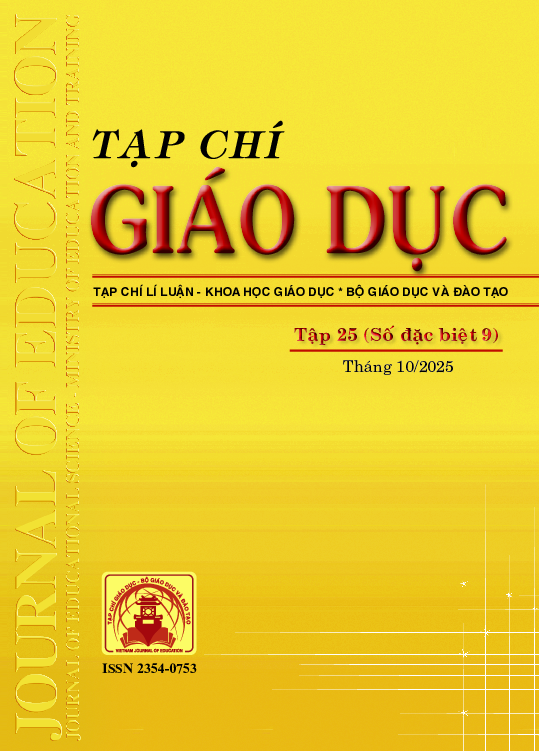Vận dụng mô hình 5E trong dạy học khái niệm “cấp số cộng” (Toán 11)
Tóm tắt
In the context of educational innovation in general education in the direction of developing learners' competence today, the requirement is that teachers need to change their teaching methods in a positive direction, focusing on learners. In particular, Mathematics needs to be organized so that students not only grasp knowledge but also develop thinking and mathematical abilities. In response to that requirement, the application of active teaching models such as the 5E model is increasingly being interested and researched in educational practice. The study presents the process of teaching Mathematics according to the 5E model in general schools and illustrates this process in teaching the concept of “Arithmetic progression” (Math 11). The lesson design is built so that learning activities correspond to each phase of the 5E model, to create conditions for students to experience, explore and generalize knowledge actively. Applying the 5E model in teaching the concept of arithmetic progression will help students move from concrete experience to abstract thinking, thereby forming deep understanding and positive attitudes in learning.
Tài liệu tham khảo
Bộ GD-ĐT (2018). Chương trình giáo dục phổ thông môn Toán (ban hành kèm theo Thông tư số 32/2018/TTBGDĐT ngày 26/12/2018 của Bộ trưởng Bộ GD-ĐT).
Bybee, R. W., Taylor J. A., Gardner A., Van, S. P., Powell, J. C., Westbrook, A., & Landes, N. (2006). The BSCS 5E instructional model: Origins and effectiveness. Colorado Springs. Co: BSCS, 5(88-98).
Cakır N. K. (2017). Effect of 5E learning Model on Academic achievement, attitude and science process skill: Meta-analysis student. Journal of Education and Training Studies, 5(11), 157-170.
Chen, S., Chen, H., & Li, Y. (2022). Study on mathematical concept teaching in high school based on 5E instructional model. Research and Advances in Education, 01(01), 1-8. https://doi.org/10.56397
Đỗ Đức Thái (chủ biên), Phạm Xuân Chung, Nguyễn Sơn Hà, Nguyễn Thị Phương Loan, Phạm Sỹ Nam, Phạm Minh Phương (2023). Toán 11 (tập 1). NXB Đại học Sư phạm.
Le, V. M. T., Nguyen, P. L., & Nhu, N. T. N. (2024). Effect of GeoGebra – supported 5E learning model on students’ understanding of the area of a trapezium: A quasi-experimental study. Mathematics Teaching-Research Journal, 16(6), 190-213.
Nguyen, T. T., Nguyen, D. N., Trinh, T. P. T., Duong, H. T., Bui, P. U., & Nguyen, N. H. (2024). Vietnamese sixth graders' mathematical communication competency developed by teaching fraction topics using the 5E model. Heliyon, 10(3), e39440. https://doi.org/10.1016/j.heliyon.2024.e39440
Phạm Thị Hồng Hạnh, Chu Thị Mai Quyên (2020). Sử dụng mô hình 5E thiết kế kế hoạch dạy học Chương 2, Hình học lớp 11 theo định hướng giáo dục STEM. Tạp chí Khoa học Giáo dục Việt Nam, 30, 19-24.
Runisah R., Herman T., & Dahlan, J. A. (2017). Using the 5E learning cycle with metacognitive technique to enhance students' mathematical critical thinking skills. International Journal on Emerging Mathematics Education, 01(01), 87-98.
Vũ Đình Chinh, Đoàn Hồ Mỹ Liêm (2024). Vận dụng mô hình 5E trong dạy học nội dung “Hình tròn. tâm, bán kính, đường kính của hình tròn” (Toán 3) nhằm phát triển năng lực giải quyết vấn đề toán học cho học sinh. Tạp chí Giáo dục, 24(số đặc biệt 5), 59-65.
Đã Xuất bản
Cách trích dẫn
Số
Chuyên mục
Giấy phép

Tác phẩm này được cấp phép theo Ghi nhận tác giả của Creative Commons Giấy phép quốc tế 4.0 .












